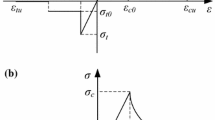Abstract
This paper presents a split Hopkinson pressure bar technique to obtain compressive stress-strain data for rock materials. This technique modifies the conventional split Hopkinson bar apparatus by placing a thin copper disk on the impact surface of the incident bar. When the striker bar impacts the copper disk, a nondispersive ramp pulse propagates in the incident bar and produces a nearly constant strain rate in a rock sample. Data from experiments with limestone show that the samples are in dynamic stress equilibrium and have constant strain rates over most of the test durations. In addition, the ramp pulse durations can be controlled such that samples are unloaded just prior to failure. Thus, intact samples that experience strains beyond the elastic region and postpeak stresses can be retrieved for microstructural evaluations. The paper also presents analytical models that predict the time durations for sample equilibrium and constant strain rate. Model predictions are in good agreement with measurements.
Similar content being viewed by others
References
Kolsky, H., “An Investigation of the Mechnical Properties of Materials at Very High Rates of Loading,”Proc. Roy. Soc. Lond. B.,62,676–700 (1949).
Kolsky, H., “Stress Waves in Solids, Dover, New York (1963).
Nicholas, T., “Material Behavior at High Strain Rates,”Impact Dynamics, John Wiley &Sons, New York, Chap. 6 (1982).
Follansbee, P.S., “The Hopkinson Bar,”Mechanical Testing, Metals Handbook, 9th ed,8,American Society for Metals,Metals Park, OH,198–217 (1985).
Nemat-Nasser, S., Isaacs, J.B., andStarrett, J.E., “Hopkinson Techniques for Dynamic Recovery Experments,”Proc. Roy. Soc. Lond. A.,435,371–391 (1991).
Ramesh, K.T. andNarasimhan, S., “Finite Deformations and the Dynamic Measurement of Radial Strains in Compression Kolsky Bar Experiments,”Int. J. Solids Struct.,33,3723–3738 (1996).
Gray, G.T., “Classic Split-Hopkinson Pressure Bar Technique,” LA-UR-99-2347, Los Alamos National Laboratory (1999).
Gray, G.T. and Blumenthal, W.R., “Split-Hopkinson Pressure Bar Testing of Soft Mateirals,” LA-UR-99-4878, Los Alamos National Laboratory (1999).
Yadav, S., Chichili, D.R., andRamesh, K.T., “The Mechanical Response of a 6061-T6 A1/A12O3 Metal Matrix Composite at High Rates of Deformation,”Acta Metall. Mat.,43,4453–4464 (1995).
Ravichandran, G. andSubhash, G., “Critical Appraisal of Limiting Strain Rates for Compression Testing of Ceramics in a Split Hopkinson Pressure Bar,”J. Am. Cer. Soc.,77,263–267 (1994).
Rogers, W.P. andNemat-Nasser, S., “Transformation Plasticity at High Strain Rate in Magnesia-partially-stabilized Zirconia,”J. Am. Cer. Soc.,73,136–139 (1990).
Chen, W. andRavichandran, G., “Dynamic Compressive Failure of a Glass Ceramic under Lateral Confinement,”J. Mech. Phys. Solids,45,1303–1328 (1997).
Pettijohn, E.R., Sedimentary Rocks, 3d ed, Harper & Row, New York (1975).
Podnieks, E.R., Chamberlain, P.G., and Thillk, R.E., “Environmental Effects on Rock Properties,” Proceedings of Tenth Symposium on Rock Mechanics, American Institute of Mechanical Engineers, New York, 215–241 (1972).
Frew, D.J., Forrestal, M.J., and Chen, W., “Pulse Shaping Techniques for Testing Brittle Materials with a Split Hopkinson Pressue Bar,” Unpublished manuscript.
Graff, K.F., Wave Motions in Elastic Solids, Dover, New York (1975).
Lewis, C.F., “Properties and Selection: Nonferrous Alloys and Pure Metals,”In Metals Handbook, 9th Edition, 2, American Society for Metals, Metals Park, OH (1979).
Farmer, I., Engineering Behavior of Rocks, 2nd Edition, Champman and Hall, New York (1983).
Olsson, B. and Mosher, D., Sandia National Laboratories, Albuquerque, NM. Unpublished notes sent to M.J. Forrestal, November 1996).
Author information
Authors and Affiliations
Rights and permissions
About this article
Cite this article
Frew, D.J., Forrestal, M.J. & Chen, W. A split Hopkinson pressure bar technique to determine compressive stress-strain data for rock materials. Experimental Mechanics 41, 40–46 (2001). https://doi.org/10.1007/BF02323102
Received:
Revised:
Issue Date:
DOI: https://doi.org/10.1007/BF02323102




